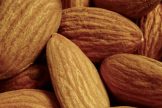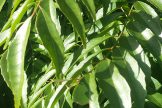
 Important note about plant availability. Important note about plant availability.There are hundreds of factsheets on our website provided for your information. Not all plants will be available at all times throughout the year. To confirm availability please call (03) 8850 3030 and ask for the nursery. |
Hazelnuts are an easy to grow nut tree suitable for backyard gardens. They require little maintenance, can be grown in most soil types and can cope with frosts. The edible nut is quite versatile and can be used in many ways. The hazelnut (Corylus avellana) is native to the temperate regions of Europe and Asia, and grows naturally as a bush or a multi-stemmed small tree, but can be pruned into a single stemmed tree as done in commercial orchards.
All hazelnuts require cross-pollination, so they need to be planted with one or more suitable polliniser varieties. They are wind pollinated, the wind blows pollen from the male flowers called catkins to the small red female flowers.
Hazelnuts are unique in that they bloom and pollinate in the middle of winter, but the flowers remain inactive until spring when fertilization and nut development occurs.
The nuts fall to the ground over a two week period in autumn, around March-April and are collected by hand. The tree can be gently shaken to encourage nuts to fall.
The trees will begin to produce nuts in 2-3 years, and reach maximum production in 6-7 years. Once established they will double in size each year till they reach maximum size. A healthy, well situated tree will produce approximately 10kg/year. Trees are productive for 40 years or more.

The basic requirements for growing hazelnuts are:
Soil: preferably well-drained, moist loamy soil with pH of 6-6.5, will but grow in most soil types with proper drainage.
Location: Full sun, tolerate frosts, chill factor of 600-1200 hours below 7°C depending on variety – ranging from about 600 hours for Tonda di Giffoni to 1500 hours for Casina.
Water: Annual rainfall of 900mm, less with irrigation
Fertilizer: Don’t fertilize in the first year, then feed only in spring in the following years.
Mulch: Place 5-7cm of mulch around root-zones to suppress competition from grass and weeds, to reduce watering requirements and to increases growth rate. Do not allow mulch to directly contact the trunk to prevent collar rot.
Pruning: Left as a shrub or bush, hazelnuts need little maintenance, but they can be pruned to increase production. Remove 15 and 20% of old growth each year to encourage new growth.
Size: up to 5m tall x 3m wide
Selecting Hazelnut Varieties
When selecting hazelnuts, choose a main cropping variety and, then select one or more matching polliniser varieties. Nearly all polliniser varieties will also produce nuts, increasing production.
Multiple polliniser varieties are used to provide early, mid and late season pollination to maximize nut production, but at the very least one polliniser variety of hazelnut is required.
Hazelnuts also need a certain amount of cold for optimum nut development, as the male catkins and female flowers require specific levels of chilling to break their dormancy. The required chill hours are important in selecting hazelnut varieties suitable to the area they will be grown in. The low chill hour varieties will shed pollen earlier and the high chill hour varieties will shed pollen later. Without enough chill hours, trees will come into leaf later, flowering is delayed, and less nuts are produced.
Melbourne averages 830 chill hours, and the actual chill hours will vary from location to location, as outer suburban areas will have more chill hours than inner city areas. Average chill hours for other regions in Victoria are much higher – Bendigo(1120), Ballarat (1180) and Wodonga (1100). As a rough guide, currants and gooseberries require 800-1000 chill hours, so if these grow in your area then most hazelnut varieties should do fairly well.

Main Nut Crop Varieties
Listed below are the main commercial varieties of hazelnuts: with a list of recommended pollinisers:
Ennis
Jumbo size nut, very high yielding, preferred variety for all general markets. Erect, vigorous tree, round nut, mid-season pollen shed with late season bloom (1040–1170 chill hours required).
Polliniser – (Early) Butler, Lewis (Mid-season) Casina, Williamette (Late) Hall’s Giant
Barcelona
Medium to large size nut, most popular nut before introduction of Ennis, slightly lower yield than Ennis. Upright vigorous tree, round nut, mid season flowering, medium chill requirements (990-1040 chill hours required).
Polliniser – (Early) Lewis (Mid-season) Casina (Late) Hall’s Giant
Butler
Large size nut, upright tree, oblong-shaped nut, mid season flowering. (1040-1170 chill hours required).
Polliniser – (Early) Lewis (Mid-season) Willamette, Casina (Late) Hall’s Giant, Epsilon
Willamette
Medium size blanchable nut, moderately vigorous tree, round nuts, early flowering. (860-990 chill hours required).
Polliniser – (Early) Barcelona (Mid-season) Casina, Tonda di Giffoni, Ennis (Late) Hall’s Giant
Lewis
Specialty small-medium size nut for confectionary market. High yielding for size of tree. Smaller tree than Barcelona.
Polliniser – (Early) Ennis, Tonda di Giffoni (Mid-season) Casina, Barcelona (Late) Hall’s Giant, Epsilon
Tonda di Giffoni
Medium size blanchable nut – similar to Willamette. Vigorous tree with relatively low chill requirements well suited to areas with mild winters and lower chilling hours (600–680 chill hours required).
Polliniser – (Early) Lewis, Willamette (Mid-season) Casina, Barcelona (Late) Hall’s Giant, Epsilon, J5
Casina
Specialty small-medium size nut for confectionary market, with high kernel weight for nut size. Moderate vigour tree, mid-late season flowering. (1395-1550 chill hours required).
Polliniser – Hall’s Giant, Butler, Ennis, Willamette, Lewis, J5
Pure Polliniser Varieties
These produce large amounts of pollen late in the season, but only produce very low nut yields, which makes them unsuitable as a main production variety.
Hall’s Giant
Mid to late polliniser variety. Upright tree with low yielding, large round nut. (990-1040 chill hours required).
Epsilon
late polliniser variety
Jemtegaard #5 (J5)
late polliniser variety, low yielding, large round nut.
Claire’s Hazelnut Tunnel
Four and a half years ago, while pregnant with my second child, my friends helped me dig over two long, south facing garden beds either side of a path. We removed running bamboo from my next-door neighbour, as well as other weeds, then we added manure, compost and zeolite to the heavy clay soil. We mounded up the beds to give better drainage.
Inspired by “The Nuttery” at Sissinghurst in the UK, my long, south facing fence was perfect to recreate this inspirational planting, although with less space than Harold Nicholson’s creation. My entire back garden is edible, except for some floral elements to attract pollinators and good bugs. So, finding edible plants that would do well in the shade was important to me. Hazelnuts are perfect.
More than one hazelnut is needed however, as they are wind pollinated, and not self-fertile. So I planted seven to make a lovely tunnel, which, I envisaged, the children would run through one day. This last year, my son declared that “Mum’s tunnel was now complete”! The understorey is planted with dry tolerant woodland plants such as native ferns, Omphalodes, Brunnera and the odd self – sown alpine strawberry.
Hazelnuts are peculiar, and beautiful. They are always interesting to watch through the seasons. During summer, the male catkins begin to form. They will produce the pollen which will be blown around by the wind, and trapped by the tiny red threads of the female flower in late winter/ early spring. The nuts begin to form, and ripen at the end of summer.
The inner squirrel in me has had me scratching around under the hazelnuts looking for fallen nuts. It is an exciting game of hide and seek. The reward this year, just over 100g of shelled, raw, hazelnuts. They are tastier roasted, so in the oven they went at 180 degrees for about 10 minutes and they were done. They tasted like heaven. They were then mixed with melted chocolate to create chocolate bars, to be shared with family and those friends who helped me plant them all those years ago… or maybe not.
By Claire McKaskill
References – Mehlenbacher, S. A. 1991. Chilling requirements of hazelnut cultivars, Scientia Horticulturae, 47,
272–282.





